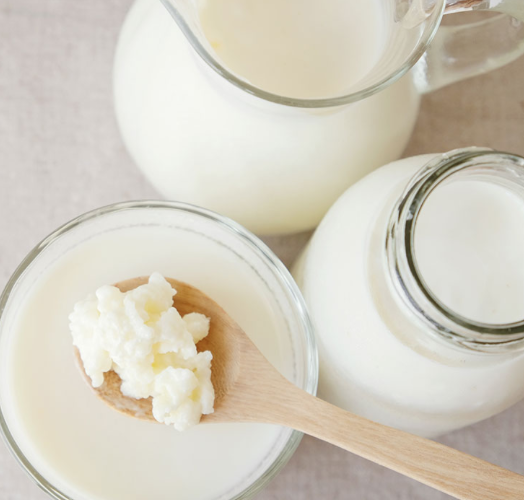Kefir is a fermented milk beverage from the Caucasus.One of the quickest and easiest ferments to make and possibly one of the most biodiverse and healthy, it is also less well-known in North America. The history is fascinating.
Ingredients:
1 quart or 1 liter of dairy milk* (I prefer goat milk) I recently discovered that raw cow milk is not the best option here, to my surprise. The raw milk has its own microbiome which competes with the kefir microbes. Best to use pasteurized cow’s milk. I wonder if the goat milk I was using was pasteurized because I had no trouble making delicious kefir with it. Anyway, live and learn!
2-3 T activated milk kefir grains
Technique:
Put the milk in a mason jar with a lid, and kefir grains and shake well. Leave on your counter overnight for up to 24 hrs. Every time you go past, give it a shake - activate your inner mixologist.
In 12 - 24 hours, the milk will become a bit gluey. When you taste it, you will detect a sour tang and it might be a little effervescent. Strain the kefir grains out, and put the kefir back in the mason jar and into the fridge. It will continue to ferment slowly, and become more tangy and sour.
Storage:
Kefir grains can be stored in the fridge in some milk for up to 2 weeks. Store it in a slightly ajar jar, :D Feed it more milk after 2 weeks to keep the grains active.
For storage up to 2 months, store the grain in sugar water. Pour some water in to small jar and add a tablespoon of sugar, stir to dissolve, then add rinsed kefir grains. Keep the lid of the jar slightly open to allow air flow.
For longer storage up to 6 months, freeze or dry the grains. First, strain the kefir grains and rinse them with water.
1) To freeze, dry them for a few hours on a paper towel, then put them in a jar or ziplock bag with some powdered milk and put them in the freezer. Write the date on the bag.
2) To dry**, leave them to dry on a parchment paper or paper towel until completely dry. They’ll turn into yellow crusty bits. Tap and turn them around a bit to ensure consistent drying. Put dried grains into a plastic zip bag together with powdered milk. Put them into the fridge for up to 6 months. Date the bag.
To reconstitute after freezing or drying, Put them into a quart of milk and simply proceed as above. It might take a few cycles of feeding and straining before they revive and completely do their thing. Don’t give up!
* If you prefer other types of milk, try it with coconut milk, or other types of “milks” (almond, hemp etc.) but should be revitalized in dairy milk for 24 hours once every 3 batches otherwise they will perish. They really need the lactose. (Emma - Disclaimer, I have not tried non-dairy milks yet. I have also noticed a “lag” when I switch between milks from different species, for example, cow to goat. It just takes the grains a bit of extra time, maybe 12 more hours. At this point, I have one set of kefir grains for cow, and a different set for goat.)
** I’m conducting a drying experiment right now. So far - I rinsed the 2-d old grains in cool boiled (so fairly sterile), water and spread them out on parchment paper. I put a sieve over them to avoid any sort of flying contamination. Will report back on trajectory and success.

